 Plant breeding in April 2022: at Lubera’s field for plant breeding trials in Buchs, Switzerland in early April. You will look in vain for laboratories and white coats. Practical plant breeding takes place first of all in the field, then in the greenhouse; thirdly via researching and evaluating on the computer and only then perhaps in the laboratory. On a Sunday afternoon (when else?), I set off on a tour of our Lubera breeding field in Buchs. What do I notice? What is the latest news? What is plant breeding anyway and what do we mean by it? What projects are we currently working on at Lubera? You can find out about all of this and more in this article.
Plant breeding in April 2022: at Lubera’s field for plant breeding trials in Buchs, Switzerland in early April. You will look in vain for laboratories and white coats. Practical plant breeding takes place first of all in the field, then in the greenhouse; thirdly via researching and evaluating on the computer and only then perhaps in the laboratory. On a Sunday afternoon (when else?), I set off on a tour of our Lubera breeding field in Buchs. What do I notice? What is the latest news? What is plant breeding anyway and what do we mean by it? What projects are we currently working on at Lubera? You can find out about all of this and more in this article.
Plant breeding at Lubera
With regard to plant breeding – at least as we practice and understand it at Lubera – there is a double misunderstanding that needs to be corrected.
Firstly, plant breeding (at Lubera) is neither high-tech nor computer science (at least as long as it does not involve mass-produced plants such as wheat, maize, potatoes, etc.). And secondly: contrary to the opinion of some nostalgic plant breeders, plant breeding is not simply the collection of existing and old varieties. Plant breeding produces new, better varieties for TODAY, for current consumer and garden trends, and it does this by directing plant sex. The breeder determines which pollen fertilises which flower and thus tries to control the random generator of free recombination of genes at least to some extent.
'And what is the art, or at best the science, in this?' you rightly ask yourself and me. Art, intuition and, of course, science are needed in plant breeding in order to ultimately select the best individual, the best group of plants, from the multitude of offspring of organised plant marriage.
But enough with the theorising; we wanted to go on a breeding tour...Let's go!
Breeding in April
April also does what it wants in terms of breeding. Blossom frosts can destroy fertilised or unfertilised blossoms, and an entire breeding year can be lost. In addition, apples always seem to blossom around Easter. And also all other early species, especially the currants, viciously tend to always flower towards a weekend; in any case, I have often wondered if this might be a subtle revenge of the berry plants for the breeders' manipulation attempts...

Picture: Ribes aureum as well as other currant species are relatively frost resistant; the flowers can withstand several degrees of frost.
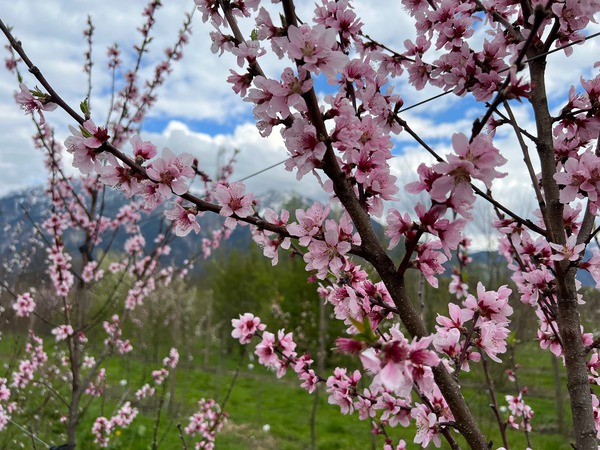
Picture: Peach blossoms, on the other hand, are extremely sensitive to the cold; 1 to 2 degrees below zero Celsius with the blossom open will destroy the harvest right at the beginning; even crossbreeding cannot be carried out successfully in such a year. So far, however, we have been spared the frost...
Controlled crossings of Ribes
Controlled crosses of Ribes, currants, gooseberries, ornamental currant, jostaberries and fourberries are a focus this early spring. This is because most domesticated Ribes species (gooseberries, blackcurrants, red currants) are self-fertile. So if you want to prevent self-fertilisation, the flowers of the mother plants must be emasculated, sterilised with a brush or even with bumblebees, before fertilisation. This means that the male flower organs are removed. The claim that only women are capable of this corresponds to an old breeding prejudice. The fine work can also be done perfectly by our male breeders.

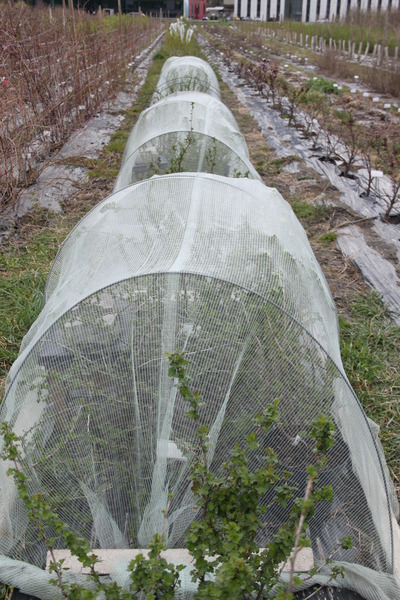


Pictures: Breeding tents – the breeding tents prevent the influx of insects, which can carry pollen of indeterminate origin. Bumblebees are released in the tents, which then bring the pollen from variety A to B and vice versa. If the flowers are emasculated beforehand, self-fertilisation can be ruled out. Since the right plants are not always placed next to each other in the field, large container plants are also used, which can be placed specifically next to the right crossing partner.

Picture: Emasculated flowers of ornamental currants: this year, these will be pollinated with blackcurrants. The goal is this: an edible ornamental currant. It is not quite clear whether such a crossing is at all promising. We will also do this process reciprocally, i.e. we will also fertilise emasculated blackcurrants with pollen from ornamental blackcurrants.

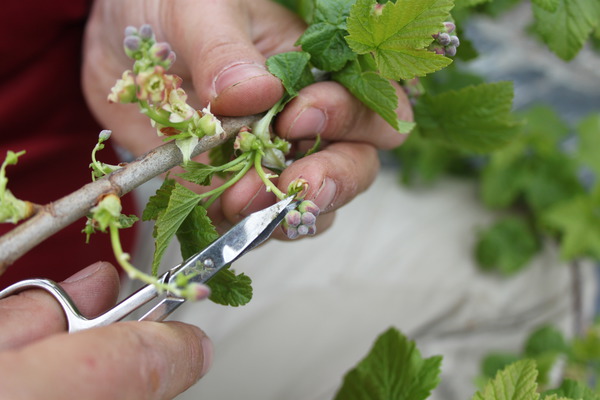
Pictures: The emasculation of blackcurrant flowers. When the flowers are still closed, the petals and stamens are removed. In most cases, the desired pollen is applied with a brush, since the flowers without petals are not attractive enough for bumblebees.
The breeding field is constantly changing
Besides our central breeding field in Buchs, Switzerland, we have other breeding fields in the canton of Thurgau (in Switzerland) and also in Germany, in Bad Zwischenahn. There we concentrate mainly on blueberries and other acid-loving plants, since the soils in this region of northern Germany have a very low acid pH. But back to the breeding field in Buchs: it is in constant change; every year about half a hectare is cleared – and at the same time half a hectare is newly planted. When a breeding population has been selected, when the best plant has been chosen, the seedling plantations can be cleared again, making room for new seedling populations. Decisive for breeding is certainly the selection, the positive selection of plants. But the timely discarding of plants that do not meet the breeding objectives is equally important. Since breeders also tend to be collectors, it is good if the scarcity of space increases the pressure to discard and to make decisions.

Picture: The breeding field – every year 5000 m² are cleared and replanted fresh.
Freshly planted cassis selections – ready for the second stage of testing
What has been positively selected in the seedling populations is transplanted as soon as possible to a new bed, with a little more space, so that it can be tested further and more precisely. Often some plants of the individual selections are then already propagated in order to have more plants available for testing. From these, the best plants are selected. Finally, one variety remains, but it is also possible that no variety is introduced. We are currently trying to improve the quality and fruit size of late, long-stringed cassis varieties. Another new separate breeding objective is to improve the leaf colour and fruitiness of the red-leaved Black'n'Red® currants.
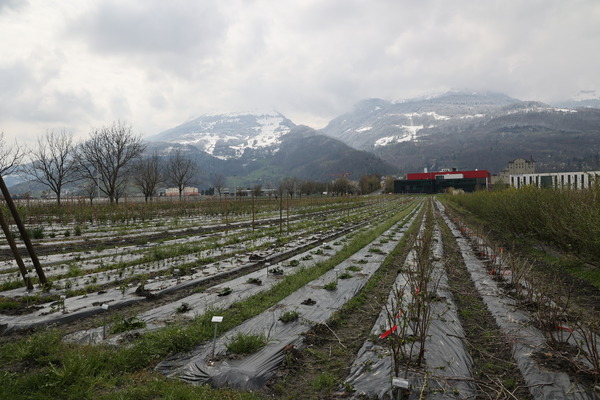
Picture: Freshly planted cassis selections, in the 2nd testing stage. These blackcurrant selections were singled out in the field in 2021. Now they have been transplanted to a new bed where they can be observed more closely. In figures, this means that we have obtained 150 selections from approx. 2000 seedlings.
Muzzled plants – tests for self-fertility
From the human point of view, self-fertility of plants is a blessing. Self-fertility, on the other hand, is quite impractical because then at least two varieties always have to be planted. From nature's point of view it is the other way round: self-fertility promotes diversity; self-fertility is à la longue a dead end, it leads to genetic uniformity, to less diversity. Very often, with cultivated plants, self-fertility only becomes established in the domestication process: humans select self-fertile plants either consciously because they prefer this trait for professional cultivation; but human selection for varieties that are as high-yielding as possible goes in the same direction, since self-fertile varieties usually tend to produce more and more regular yields.
And the muzzled plants, with the bag over their heads? Here we are testing new Ribes aureum varieties, the so-called fourberries, for self-fertility. In recent years, we have selected a whole new and also super-exciting range of fourberries, with larger orange-coloured berries, but also with wine-red berries. Before the final market launch, however, we now have to test which varieties are self-fertile and which are not...
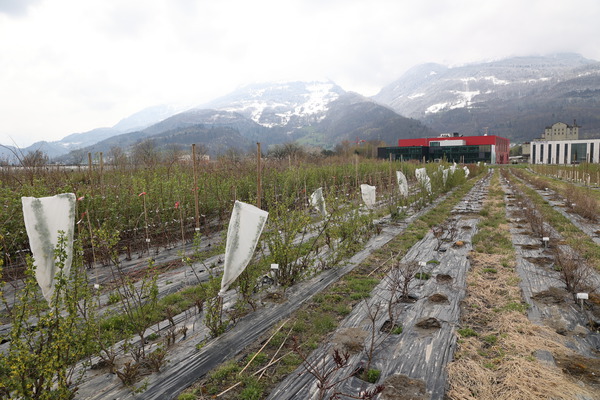
Picture: New Ribes aureum varieties with bags over their heads; the bag prevents the influx of pollinating insects. If the bagged flowers set fruit, the corresponding variety is self-fertile; if there are no fruits, there is no or only insufficient self-fertility.

Picture: Tests for self-fertility in Ribes aureum and Ribes odorateum: those plants that still set fruit are self-fertile.
Accidents...and breeding: new ornamental currants
It is not seldom that failures, even accidents, miraculously lead to unexpected breeding results. A few years ago we tried to cross blackcurrants and ornamental cassis (as mentioned above, we are still trying to do so): unfortunately without success. The seeds of the cassis mother plants only produced blackcurrants again, the seeds of the ornamental currants developed into...ornamental blackcurrants. From the latter, however, we have now selected two beautiful new variety candidates that will be introduced in a few years: they are very attractive, fast growing bushes that flower from bottom to top with early, intense red blooms and they have a higher plant health than standard varieties...

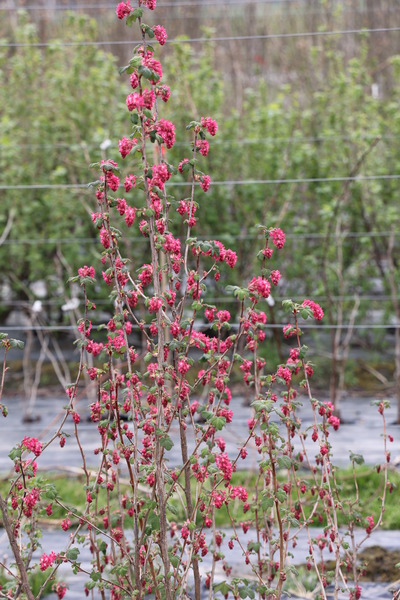

Pictures: New candidate varieties of red-flowered ornamental currant/blood currant, about two years before variety introduction.
Pear breeding – a question of patience
Somewhat impatiently I look at the rows of pear cultivars...Pears really need patience: even in the 4th and sometimes 5th year after planting, only a small minority of seedlings grafted on to quince bear flowers and then hopefully fruit. It simply takes a long time for the trees to grow out of juvenility (visible on the spiny shoots) and then usually start to flower at the top of the tree. But with a bit of luck and without spring frost, we can taste the first fruits here this year and get a first impression of the breeding combinations.
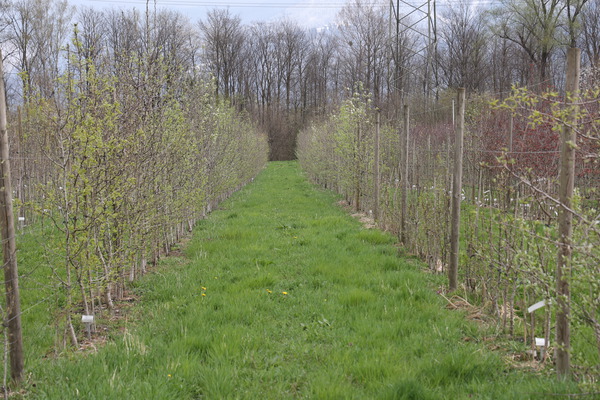
Picture: Pear seedlings, most of them still without flowers.
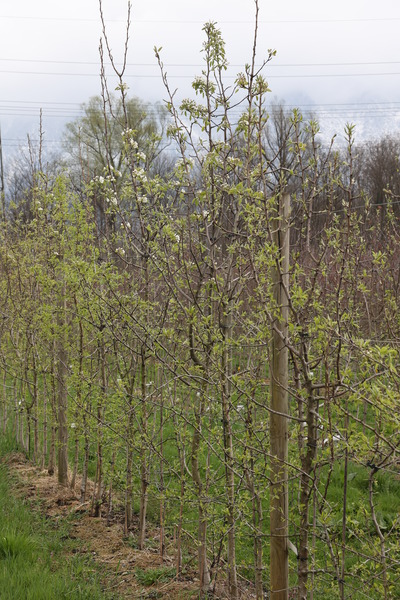
Picture: A few pear seedlings are starting to flower at the top.
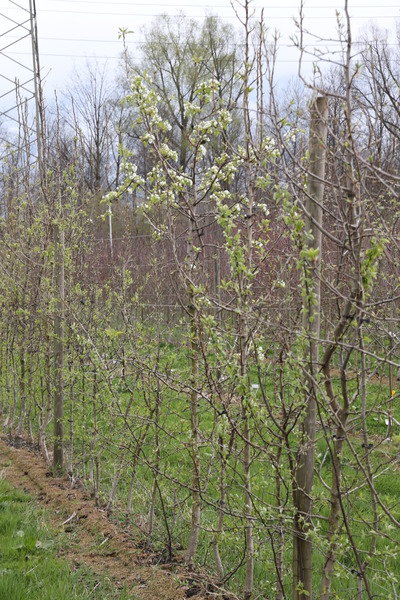
Pictures: Pear seedlings that are flowering; we are eagerly and patiently waiting for autumn.
Peach seedlings on their own root
Peach cultivation is much faster. These seedlings are now entering their second year here in the breeding field (they are three years old in total) and are already showing their first flowers. Next year at the latest, everything will be in flower here – and with a bit of luck, a final selection will probably already be possible. You know now that breeding space is scarce; it has to be scarce, otherwise real breeders would never part with their plants. The selection of peaches is also relatively simple: everything that has a strong to medium infestation with peach leaf curl will be consistently selected away. In peach breeding, we want to concentrate on varieties that are tolerant to peach leaf curl disease and exhibit very strong, healthy growth.
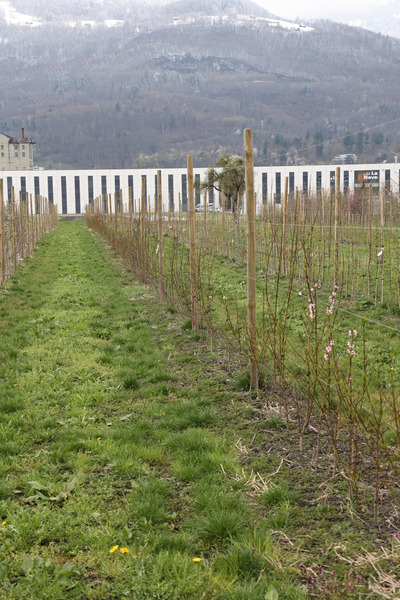
Picture: A row of peach seedlings; crosses between varieties that are tolerant to peach leaf curl disease and Prunus mira breeding lines.
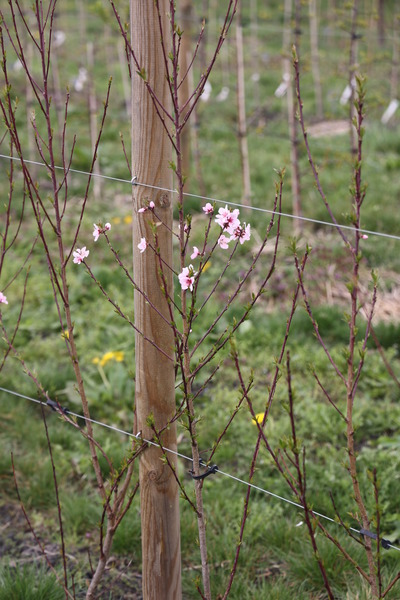
Picture: Sporadically, the first blossoms can already be seen in the field in the 2nd year.
The future of the common serviceberry
What is this? Admittedly, photographed a bit too early, the countless flower panicles are not yet fully developed...
These are probably the most interesting Amelanchier/common serviceberry cultivars in our wild fruit programme: not only are the plants only about half as vigorous in growth as normal Amelanchier alnifolia varieties (saskatoon), they are also much more prolific. Presumably, the two characteristics are also closely related. If we succeed in raising the fruit size and the quality of the berries of the compact plants to the level of the best current cultivars (level cultivar 'Martin'), whole new possibilities will open up for the saskatoon in the garden due to its compact growth. Since the birds have also learned to appreciate the saskatoon berries in our breeding field, it will not work without bird protection netting from the time the colour change takes place (i.e. starting about mid to late May).
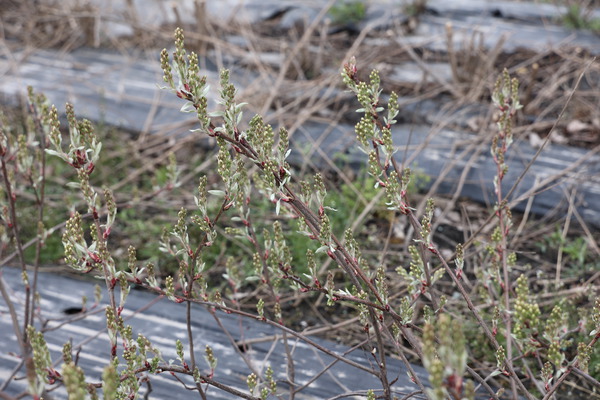
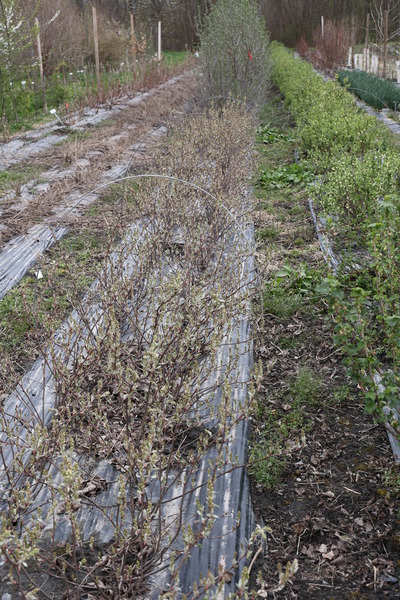
Pictures: Compact, super-fruitful Amelanchier seedlings.
Sea buckthorn – with sugar and without (?) thorns
We are currently introducing the new Ukraine sea buckthorn varieties (more information to come in the next garden letter). At the same time, however, we have already started to continue breeding with these new varieties ourselves. Here you can see a population of sea buckthorn that will fruit for the first time this year. What we are interested in is this: fruit size +/- 1 g, ideally over 1 g, short stems, high sugar values with low acid values (sugar/acid ratio 3-5) and compact, preferably thornless growth.
Conclusion of the Sunday afternoon
If you want more, you have to breed plants.
And what do we want and wish for?
These desires will surely come true one Sunday afternoon. Until then: keep on breeding!
